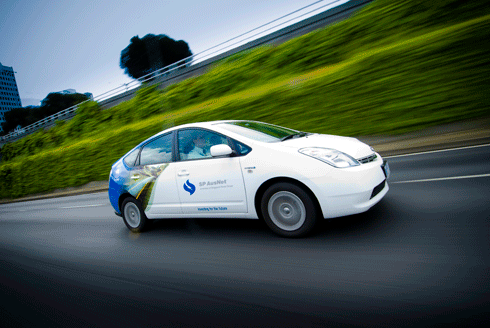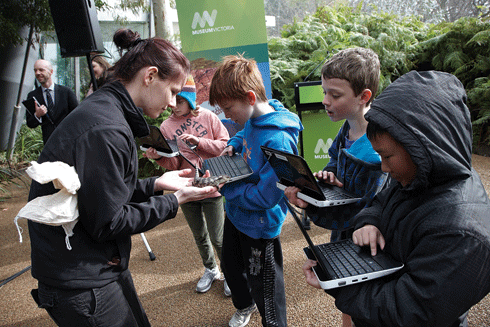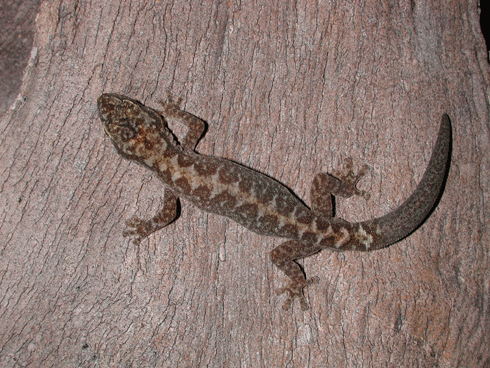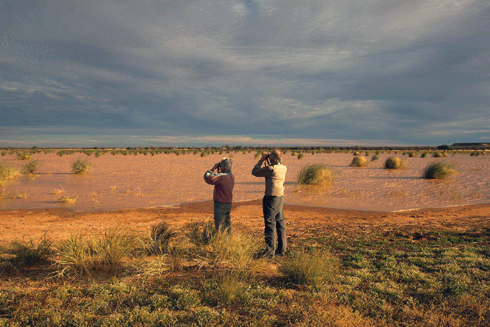
|
Published: 25 October 2010
Powering up
Electric cars are gaining traction. In Germany, for example, the car industry is working with government to get a million electric cars onto the roads by 2020 – that’s one in four new cars sold in 2020. But there are other opportunities – and challenges – emerging for Australia, reports Graeme O’Neill.
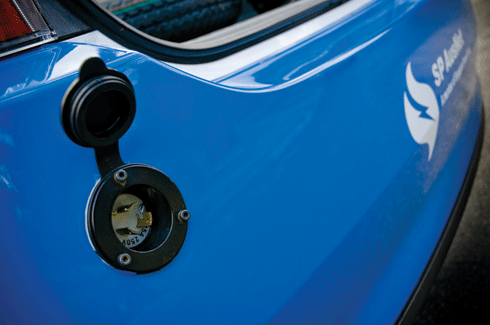
|
|
Accessing the ‘fuel tank’ on the CSIRO plug-in hybrid electric vehicle. Credit: CSIRO
|
Ross Blade, founder of Victorian electric vehicle maker Blade Electron Victoria (BEV) says it has been ‘a long, tough road’ to build up his electric vehicle company.
From its factory in the old gold-mining city of Castlemaine, BEV is preparing to scale up production from around 30 new Electron vehicles a year, to 50 and, eventually, 370.
All 30 Electrons built to date were based on new Hyundai Getz hatchbacks imported from South Korea, but production is about to shift to the Getz’s successor, the i20. The company’s Australian-made electric motor, drive train, batteries, and battery-management system, fit straight into the i20.
BEV suffered a recent setback when the Australian Government decided to lease 40 new Japanese Mitsubishi i-MiEV electric vehicles (EVs) for the Commonwealth car fleet, at $1740 per month each. The Electron MkIV was excluded from consideration, despite being some $800 cheaper to lease. It did not qualify as a mass-produced vehicle, and did not yet meet the Commonwealth’s EV program guidelines.
How does a home-grown Australia company become a mass producer? Through contracts to supply government fleets. But to qualify, it must be a mass producer –Catch-22.
In its Getz incarnation, the Electron met Australian design regulations, and Ross Blade asserts the new model’s technical superiority over the i-MiEV. He designed it to provide a genuine 100 km per charge at normal stop-start driving speeds ‘with a few hills thrown in’.
Blade rejects the description ‘conversion company’, pointing out that BEV manufactures brand new vehicles, from a single model. It replaces the original Hyundai petrol engine and drive train with a new Australian electric motor, drive train, battery pack and battery management system. The original, new petrol engines will be sold as power sources for off-grid generation.
‘We’ve gone beyond what one would regard as a conversion,’ Blade says. ‘By the end of the year, 50 per cent of our vehicles will consist of original components manufactured in Australia, and will account for 75 per cent of the cars’ $53 000 value.’
The new Hyundai i20-based Electron has yet to be certified crashworthy although, as it is basically a next-generation Getz, which has already passed Australian crash tests, there should be no problem.
Blade says buyers prepared to spend $53 000 on a new Electron EV are typically ‘middle-upper income career people with a conscience, who see themselves as seeding a new industry’.
Dr Phillip Paevere, a program leader with CSIRO’s Energy Transformed Flagship, says large numbers of EVs on Australia’s roads will create options for a more efficient power grid.
Paevere heads CSIRO’s Electric Driveway project, which aims to integrate electric vehicles into household power systems, where they can act as a distributed system for storing off-peak power from the national grid.
A perennial problem for coal-fired power stations is that demand for energy during the day greatly exceeds overnight demand. Paevere’s team is developing algorithms for intelligent household energy-management systems that would allow an electric vehicle to be charged at off-peak rates overnight. After a day’s commuting, the system would enable the car to discharge residual energy into the household system to run appliances and lighting during the evening high-demand period.
‘It would benefit energy providers to have extra storage capacity, because it allows load-levelling, and the constant full charging and discharging doesn’t wear out the vehicle’s batteries any faster,’ says Paevere.
Developing the Electronic Driveway, he adds, involves ‘a whole lot of unknowns’. Power utilities would need new business models to ensure customers share the savings from postponing investment in new power-generating infrastructure. And households with electric vehicles would need incentives to commit to sustainable charging behaviour.
Paevere says the popular concept of electric vehicles pulling into a charging station for a 5-minute refill holds little appeal for power utilities, because thousands of electric vehicles pulling a quick 25 kilowatts per hour (kW/h) ‘fill’ off the power grid on the way to or from work, will only exacerbate the problem of managing grid load.
Recent research – including an EV trial run by the Victorian Government as part of the Electric Driveway study – shows most drivers commute less than 100 km per day, so the EV’s 100 km range should be more than adequate. In future, the average two-car family could have an EV commuter, and a long-haul petrol- or diesel-electric hybrid.
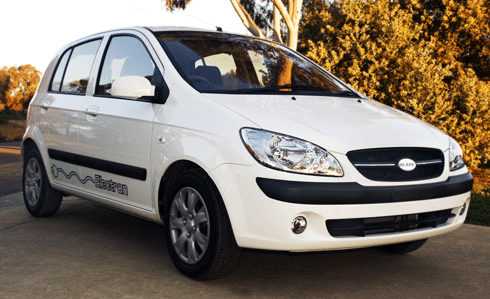
|
|
The Blade Electron – Australian ingenuity competing with imports. Credit: Blade Electron Victoria
|
Paevere says his team is looking at the opportunities, and developing prototypes of the necessary hardware for the Electric Driveway, that they would develop in partnership with private companies.
‘The issue of where to keep the system’s “smarts” will be a bit of a battleground – vehicle manufacturers, and companies like Google, Microsoft and Cisco, are contending to host the system’s intelligence and telecommunications.
‘We’re hardware-agnostic in CSIRO. Persuading people to move to EV transportation and adopt the required charging behaviour will require incentives, and it’s government’s role to ensure a range of models is offered. But all the players agree that, if we foster widespread uptake, everyone will share the benefits.’
Cost, and the misplaced expectation that EVs will perform like petrol cars will impede adoption, but Paevere expects demand for petrol-to-electric conversions to decline as more manufacturers, including smaller companies with no history of making conventional vehicles, enter the EV market.
Kristian Handberg, manager of Victoria’s EV project, says the project’s aim is to make Victoria an ‘EV-friendly place’.
‘It’s a test bed for assessing user performance and experience of different technological solutions. It provides all participants with a safe, low-cost operating environment to test out different models.’
The trial involves several hybrid-electric buses, plug-in light commercial EVs, and a ‘limited representation’ of plug-in hybrids. Handberg says the aim is to identify barriers to efficient function, test solutions, and guide an efficient and safe rollout of the EV market in Victoria.
‘Victoria has extremely competitive electricity prices, so it lends itself to an EV market, but the state’s reliance on brown coal comes with a significant emission profile,’ Handberg says.
‘Whatever the mix, if owners source energy from the grid, the emissions benefit will be debatable. It will only be with the reduction of carbon emissions from the stationary engine sector that the benefits will become undeniable.’

|
|
The Australian Government has decided to lease 40 new Japanese Mitsubishi i-MiEV electric cars for the Commonwealth car fleet. Credit: Mitsubishi
|
Rhys Freeman, Green Technology Manager for the Centre for Education and Research in Environmental Strategies (CERES) in the inner Melbourne suburb of Brunswick, describes the EV market in Australia and the US as ‘very healthy’.
In the US, all sales of Nissan’s entry in the electric stakes – the LEAF (Leading Environmentally friendly Affordable Family car) – were reserved before production began. The LEAF will come to Australia in 2012.
Freeman says new technologies are easing lingering concerns about EVs, such as their short range, short battery life and inconveniently long charging times.
Embodied energy – the energy invested in making the vehicles and their batteries –influences the choice between a new EV and a conversion. Freeman says conversion is usually a cheaper option for commercial vehicles because few commercial EVs are available, and owners prefer to choose a vehicle that suits their needs. Conversion costs range from $10 000 to $50 000, with the choice of vehicle.
But people usually convert to save the environment, not money, says Freeman, as converting cars to electric will reduce the requirement for making new EVs and prevent millions of cars going to landfill.
More information
CSIRO Electric Driveway project, www.csiro.au/files/files/ptec.pdf
Blade Electric Vehicles, http://bev.com.au/


